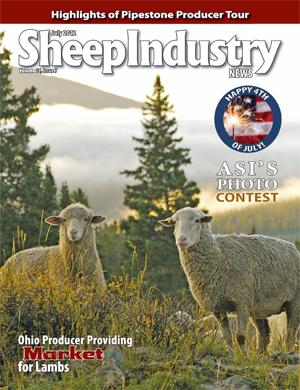
- July 2012
- ALB Encourages Industry Response to Sustainability Survey
- ASI Conducting Photo Contest-July
- Executive Board Makes ALB and NSIIC Nominations
- Slyter Retires as Editor of Research Journal
- ASI Conducting Photo Contest-July
- From One Side of the Industry to Another
- Pipestone Producers Share Management Techniques
- Sheep can Reduce Sawfly in Stubble Fields
- Ribeye Research: Projects begin to stress ribeye measurements in sheep
- NSIIC Requests Grant Proposals
Ribeye Research: Projects begin to stress ribeye measurements in sheep
By CHRISTY MARTINEZ
Reprinted from the Wyoming Livestock Roundup
(July 1, 2012) About six years ago a joint project between Montana State University (MSU) and the Montana Wool Growers Association began. The research looked at ribeye information on Targhee, Rambouillet and Columbia sheep, and project participation from producers in Montana has only grown since then.
The research began with both the registered Targhee flock at MSU, as well as Targhee, Rambouillet and Columbia producers in the state.
“We worked on getting them involved and getting their rams scanned and the ribeye information reported in their sale processes,” says MSU research scientist Lisa Surber, Ph.D., who works with the Montana Sheep Institute. “It happened slowly at first with producers, but now, and since about four years ago, almost every producer who sells rams at the Montana Ram Sale in Miles City, Mont., now reports ribeye information.”
Surber recalls that, in the first year of reporting ribeye information, one of the first producers to participate reported a $250-per-head gain just from having that information.
“Lambs are beginning to be sold on the grid, as opposed to just being sold on a weight basis, and that ribeye is becoming more and more important to producers who are selling within cooperatives,” says Surber. “The fact that Montana producers are selling rams with that information makes that much more appealing to those types of producers.”
Surber adds that the 2012 Montana Ram Sale this fall will be the first to report estimated breeding values for carcass merit.
“That was solely to do with the research at MSU that started the process of figuring out the relationship between weights and ribeye and moving toward collecting the data and actually have a genetic performance estimate for those producers, and that’s a big step,” she says.
Ribeye in Wyoming
In Wyoming, sheep producers haven’t started to do as much with measuring ribeye, thought there is an interest, says Frank Moore of the Mountain States Lamb Cooperative.
“We aren’t using it on the meat side, because we’re marketing on the yield grade of the lambs,” says Moore. “We tried to do a visual imaging process when we first got started, and it worked really well, but it was too expensive. At some point I think it would be a great tool, and I’d like to see the industry go that way. I hope we can get there, because the yield grade doesn’t really give us the information that imaging and measuring the ribeye does.”
Moore says a handful of U.S. companies are trying to perfect the process, and that there is additional research with the support of both the U.S. Department of Agriculture and the industry, and that there are some ongoing pilot programs.
As far as measuring Wyoming rams for ribeye, Moore says he sees a definite interest from producers.
“We’ve got a lot of room in the sheep industry for improvement, and to get caught up with the other meats,” he sates. “A lot of our members are looking at ribeye information on rams, and when that information is available they’re using it.”
Ribeye and Ewes
To date, the majority of ribeye measurement and research has been done on rams, because the ewe side is so much more complex.
“Most of the white-faced rams are managed in a very similar fashion – they’re on the ewes until August or September, then they go through a transition period and most purebred producers put them on some kind of a performance diet so they’re actively growing through the winter time,” explains Surber. “That’s when we like to measure those rams, and the style of management is very similar.”
However, she says ewes are managed in a variety of ways.
“Some producers try to breed them as ewe lambs, and some wait to breed them as yearling ewes,” she says. “That adds an element that’s more difficult to get our hands around.”
Surber says they have measured some yearling ewes, and some producers have used that information to screen out the bottom end, or to make sire selections to boost something like ribeye in the lambs that come from the ewes.
“Our next research project will look at when is the best time to measure those ewes,” she says. “Whether that be as ewe lambs or as yearling ewes – at what phase of growth do we measure? Typically they’re not put on a performance-type diet that’s similar across all producers’ management systems.”
Ribeye in the Future
Surber says she doesn’t see a clear end to the ribeye research project.
“Until we’re selling every lamb like we sell the vast majority of beef cattle, there won’t be a tremendous amount of incentive to measure ribeye, unless you’re involved in a cooperative that puts pressure on those types of traits,” she says.
She adds that sheep are also different from beef cattle, in that there are many other traits to also worry about, including maternal, performance and wool.
“We don’t have a good idea of what impact selection for carcass merit has on some of the maternal traits like twinning, or wool production,” she says. “There are tremendous avenues for additional research looking at those interactions. I don’t see an end to this research, but another question to be answered.”
“As an industry, we’re interested in improving everything that gives us a better meat product,” adds Moore.

